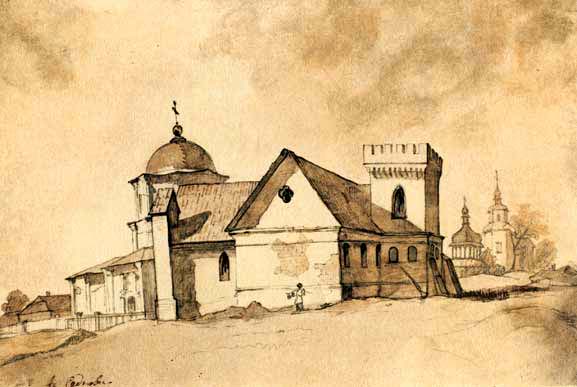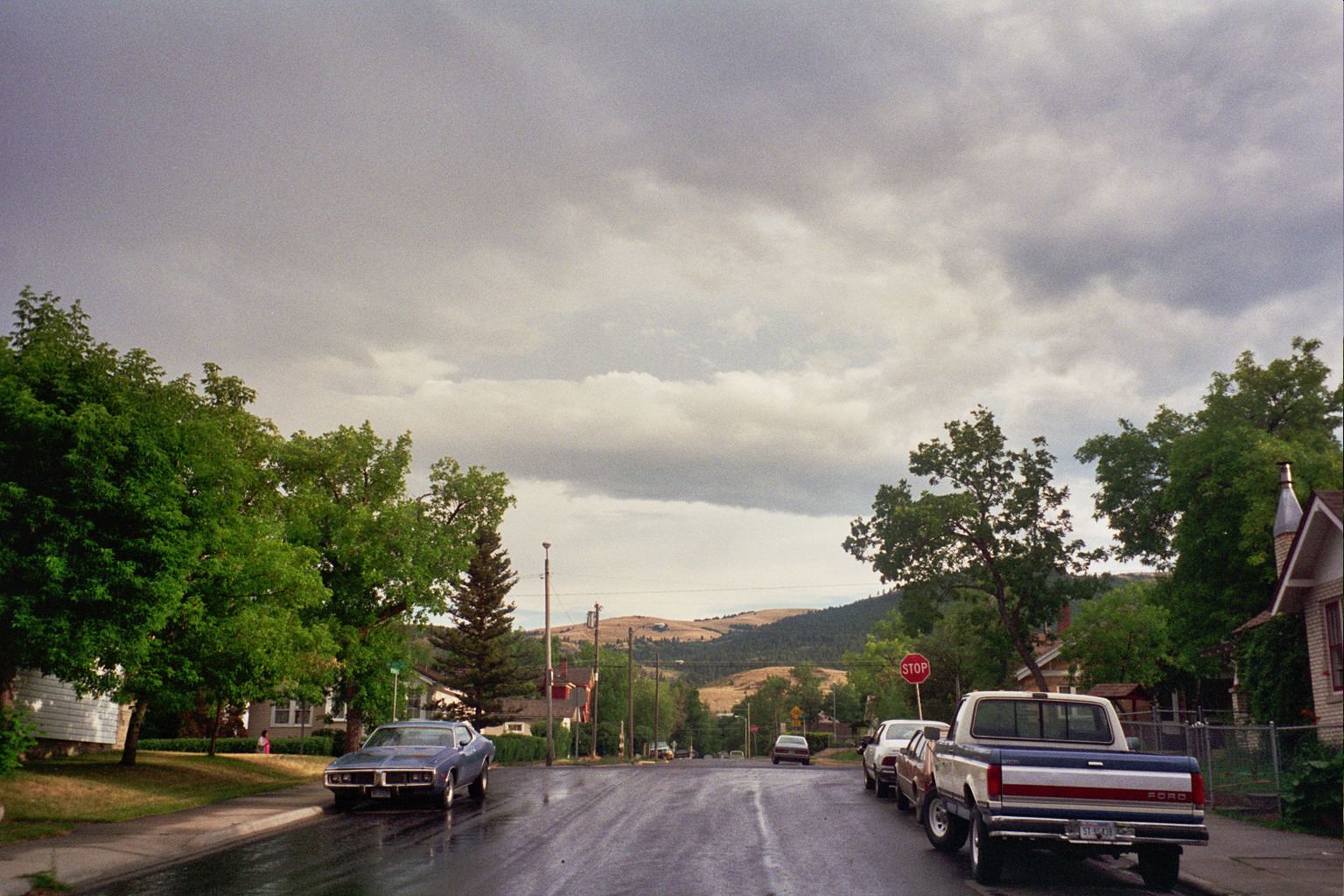|
Lyzohubs' Stone House
The Lyzohubs' Stone House is a manor in Sedniv, Chernihiv Oblast, Ukraine. It is the oldest stone residential building on Left-bank Ukraine. It was built for Yakiv Lyzohub of Chernihiv Regiment, member of the Lyzohub family. Constructed in the 17th century, the building is a Ukrainian architectural monument. History The building was constructed in 1690 on the territory of the estate of the Chernihiv colonel Yakiv Lyzohub by his order by the same artisan team that was building the Church of the Nativity of the Virgin Mary in Sedniv at the same time. The roof was originally covered with shingles. In the second quarter of the nineteenth century, instead of a porch, a tower with Gothic windows, fortified by buttresses, was built on the main façade, crowned with a band of decorative mashikuls and merlon teeth. The house was painted in 1846 by Taras Shevchenko, who was visiting the then owner of the estate, Andriy Lyzohub. In September 1930, the monument was examined and measure ... [...More Info...] [...Related Items...] OR: [Wikipedia] [Google] [Baidu] |
Sedniv
Sedniv (Ukrainian language, Ukrainian: Седнів, Yiddish language, Yiddish: סעדניוו) is a Populated places in Ukraine#Rural settlements, rural settlement in Chernihiv Oblast, Ukraine. Located in Chernihiv Raion, Sedniv is the seat of the Sedniv settlement hromada, one of Ukraine's 435 settlement hromadas. It has a population of Sedniv is famous for being the hometown of the Lyzohub family of Cossacks. The population of Sedniv suffered heavily from the Holodomor, or Ukrainian Famine, causing it to lose its township status in 1932. More than 25 years later, in 1959, Sedniv was restored to a ton. Sedniv is located at the historic site of the Ruthenian city of Snovsk, then part of Kievan Rus', which was destroyed by the Tatars in 1239. It is unknown when the town changed its name from Snovsk to Sedniv. In 1648-1781 it was a district (sotnia) seat of the Chernihiv region (polk). History Prehistory Modern researchers trace the history of Sedniv to the Danish settlement ... [...More Info...] [...Related Items...] OR: [Wikipedia] [Google] [Baidu] |
Left-bank Ukraine
The Left-bank Ukraine is a historic name of the part of Ukraine on the left (east) bank of the Dnieper River, comprising the modern-day oblasts of Chernihiv, Poltava and Sumy as well as the eastern parts of Kyiv and Cherkasy. Left-bank Ukraine is bordered by the historical regions of Right-bank Ukraine to the southwest, Zaporizhzhia to the southeast, Sloboda Ukraine to the east, and Polesia and White Ruthenia to the north. History Since the Middle Ages, the region formed part of the Khazar Khanate, Kievan Rus', Mongol Empire, Golden Horde, Grand Duchy of Lithuania and the Kingdom of Poland. The term appeared in 1663 with the election of Ivan Bryukhovetsky as the hetman of Ukraine in opposition to Pavlo Teteria. Bryukhovetsky was the first known "left-bank Ukraine" hetman over the area, that was under the Russian influence. Up until the mid-17th century, the area had belonged to the Polish–Lithuanian Commonwealth. The Treaty of Pereyaslav of 1654 saw the region tent ... [...More Info...] [...Related Items...] OR: [Wikipedia] [Google] [Baidu] |
Chernigov Regiment
The Chernigov Regiment (also known as ''Chernihiv Regiment'' or the ''Regiment of Chernigov'', , ) was one of ten territorial-administrative subdivisions of the Registered Zaporozhian Host, later incorporated as an autonomy in Tsardom of Russia. In 1781, the regiment was officially abolished, and territory was reformed into the Government of Chernigov, Russian Empire. The Chernihiv Regiment was founded in 1648 during the Khmelnytsky Uprising. Following the signing of the Treaty of Zboriv in 1649 it consisted of 7 sotnias, and had 997 registered cossacks. After Treaty of Pereyaslav very much parts of regiment was included to Nizhyn Regiment. With 1659 in regiment started creation new sotnias. After reformation Chernihiv Regiment in 1782 consisted of 16 sotnias: Bereznynska, Bilouska, Chernihiv regimental, Horodnyanska, Kyselivska, Lyubetska, Menska, Ponurnynska, Royiska, Sednivska, Slabynska, Sosnytska, Stolynska, Synyavska, Volynska, Vybelska, According to documents of ... [...More Info...] [...Related Items...] OR: [Wikipedia] [Google] [Baidu] |
Lyzohub Family
The Lyzohub family (; Russian: ''Лизогубы''; also spelled as ''Lizohub, Lisohub, Lizogub'') was a Ukrainian family of the Cossack Hetmanate. For years many members of the family held high offices in the Ukrainian government. Origins There are two versions of the origins of the Lyzohub family. One claims they descended from the Kobyzewicz family who were Lithuanian boyars. According to the historian Volodymyr Antonovych who referred to the chronicles of the Lyzohub family, the family was descended from a Cossack Klym Lyzohub who was killed in action in the battle of Lviv in 1648.Ервін Міден. ЖИТТЄПИС ЯКОВА КІНДРАТОВИЧА ЛИЗОГУБА//Juvenia studia : Збірник студентських наукових праць. Випуск 5. / Інститут історії, етнології та правознавства імені О. М. Лазаревського. – Чернігів : Десна Поліграф, 2015. C. 45. The ... [...More Info...] [...Related Items...] OR: [Wikipedia] [Google] [Baidu] |
Ukraine
Ukraine is a country in Eastern Europe. It is the List of European countries by area, second-largest country in Europe after Russia, which Russia–Ukraine border, borders it to the east and northeast. Ukraine also borders Belarus to the north; Poland and Slovakia to the west; Hungary, Romania and Moldova to the southwest; and the Black Sea and the Sea of Azov to the south and southeast. Kyiv is the nation's capital and List of cities in Ukraine, largest city, followed by Kharkiv, Odesa, and Dnipro. Ukraine's official language is Ukrainian language, Ukrainian. Humans have inhabited Ukraine since 32,000 BC. During the Middle Ages, it was the site of early Slavs, early Slavic expansion and later became a key centre of East Slavs, East Slavic culture under the state of Kievan Rus', which emerged in the 9th century. Kievan Rus' became the largest and most powerful realm in Europe in the 10th and 11th centuries, but gradually disintegrated into rival regional powers before being d ... [...More Info...] [...Related Items...] OR: [Wikipedia] [Google] [Baidu] |
Yakiv Lyzohub
Yakiv Yukhymovych Lyzohub () was a military and political figure of the Cossack Hetmanate and a member of a well known Cossack family of Lyzohub. He was born in a family of Chernihiv Colonel Yukhym Yakovych Lyzohub and Lyubov Petrivna Doroshenko. Yakiv Lyzohub was a grandson of Hetman Petro Doroshenko. He graduated from the Kyiv-Mohyla Academy that in the 19th century was transformed into the Kyiv Theological Academy on the order of the Russian Holy Synod. In 1713-28 Lyzohub was a Bunchuk General. In 1723-24 he along with Colonel Danylo Apostol and Yesavul General Vasyl Zhurakovsky was imprisoned by Peter the Great in the Peter and Paul Fortress as a members of Pavlo Polubotok's party. After the release Lyzohub was forced to live for sometime in Saint Petersburg. During the hetman rule of Danylo Apostol, in 1728 he was promoted to the rank of Quartermaster General. After the death of Danylo Apostol in 1734, Lyzohub was placed as an Appointed Hetman in the Governing Counc ... [...More Info...] [...Related Items...] OR: [Wikipedia] [Google] [Baidu] |
Buttress
A buttress is an architectural structure built against or projecting from a wall which serves to support or reinforce the wall. Buttresses are fairly common on more ancient (typically Gothic) buildings, as a means of providing support to act against the lateral (sideways) forces arising out of inadequately braced roof structures. The term ''counterfort'' can be synonymous with buttress and is often used when referring to dams, retaining walls and other structures holding back earth. Early examples of buttresses are found on the Eanna Temple (ancient Uruk), dating to as early as the 4th millennium BC. Terminology In addition to flying and ordinary buttresses, brick and masonry buttresses that support wall corners can be classified according to their ground plan. A clasping or clamped buttress has an L-shaped ground plan surrounding the corner, an angled buttress has two buttresses meeting at the corner, a setback buttress is similar to an angled buttress but the buttresses ... [...More Info...] [...Related Items...] OR: [Wikipedia] [Google] [Baidu] |
Taras Shevchenko
Taras Hryhorovych Shevchenko (; ; 9 March 1814 – 10 March 1861) was a Ukrainian poet, writer, artist, public and political figure, folklorist, and ethnographer. He was a fellow of the Imperial Academy of Arts and a member of the Brotherhood of Saints Cyril and Methodius. He wrote poetry in Ukrainian language, Ukrainian and prose (nine novellas, a diary, and his autobiography) in Russian language, Russian, making him one of many iconic figures which belong to several Slavic language cultures. The town of Aktau in Kazakhstan was named after Shevchenko in the period of Soviet authority. His literary heritage, in particular the poetry collection ''Kobzar (poetry collection), Kobzar'', is regarded to be the foundation of modern Ukrainian literature and to some degree also of the modern Ukrainian language. Life Childhood and youth Taras Shevchenko was born on in the village of Moryntsi, Kiev Governorate, Russian Empire, about 20 years after the third partitions of Poland, partiti ... [...More Info...] [...Related Items...] OR: [Wikipedia] [Google] [Baidu] |
Andriy Lyzohub
Andriy or Andrii () is the Ukrainian form of a masculine . The name is equivalent of in the . Given name People with this name include * * * See ...
|
Stefan Taranushenko
Stefan may refer to: * Stefan (given name) * Stefan (surname) * Ștefan, a Romanian given name and a surname * Štefan, a Slavic given name and surname * Stefan (footballer) (born 1988), Brazilian footballer * Stefan Heym, pseudonym of German writer Helmut Flieg (1913–2001) * Stefan (honorific), a Serbian title * ''Stefan'' (album), a 1987 album by Dennis González See also * Stefan number, a dimensionless number used in heat transfer * Sveti Stefan or Saint Stefan, a small islet in Montenegro * Stefanus (other) Stefanus may refer to: * A variation of the given name Stephen, particularly in regard to: ** Saint Stephen Stephen (; ) is traditionally venerated as the protomartyr or first martyr of Christianity. [...More Info...] [...Related Items...] OR: [Wikipedia] [Google] [Baidu] |
Second World War
World War II or the Second World War (1 September 1939 – 2 September 1945) was a World war, global conflict between two coalitions: the Allies of World War II, Allies and the Axis powers. World War II by country, Nearly all of the world's countries participated, with many nations mobilising all resources in pursuit of total war. Tanks in World War II, Tanks and Air warfare of World War II, aircraft played major roles, enabling the strategic bombing of cities and delivery of the Atomic bombings of Hiroshima and Nagasaki, first and only nuclear weapons ever used in war. World War II is the List of wars by death toll, deadliest conflict in history, causing World War II casualties, the death of 70 to 85 million people, more than half of whom were civilians. Millions died in genocides, including the Holocaust, and by massacres, starvation, and disease. After the Allied victory, Allied-occupied Germany, Germany, Allied-occupied Austria, Austria, Occupation of Japan, Japan, a ... [...More Info...] [...Related Items...] OR: [Wikipedia] [Google] [Baidu] |
Residential Buildings In Ukraine
A residential area is a land used in which housing predominates, as opposed to industrial and commercial areas. Housing may vary significantly between, and through, residential areas. These include single-family housing, multi-family residential, or mobile homes. Zoning for residential use may permit some services or work opportunities or may totally exclude business and industry. It may permit high density land use or only permit low density uses. Residential zoning usually includes a smaller FAR (floor area ratio) than business, commercial or industrial/manufacturing zoning. The area may be large or small. Overview In certain residential areas, especially rural, large tracts of land may have no services whatever, such that residents seeking services must use a motor vehicle or other transportation, so the need for transportation has resulted in land development following existing or planned transport infrastructure such as rail and road. Development patterns may be regul ... [...More Info...] [...Related Items...] OR: [Wikipedia] [Google] [Baidu] |



